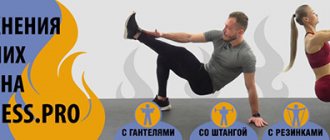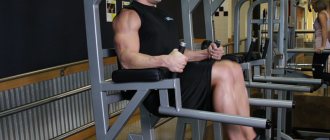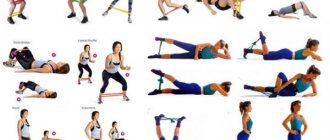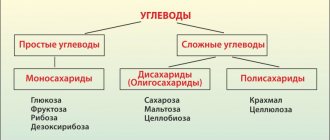Two vertical muscles run along the abdomen from the intercostal arch to the pubic bone. They are connected to each other by a white membrane of tendons. Normally, the muscles fit tightly to each other, but there are times when the membrane loses its elasticity and can no longer hold the muscles as before. Most often this happens in the last stages of pregnancy, but there are other reasons. The weakening of the membrane is called diastasis, and we will talk about it today.
- What is diastasis
- How to diagnose
- Physical exercises for diastasis “Cat”
- Retraction
- Kegel technique
- Julia Tupler's technique
- "Shoulder Bridge"
- "A hundred"
- "Pull"
- "Lumbar Stretch"
Basic facts about diastasis
Why this trouble appears, no one can still reliably and confidently say. However, there are versions that are 100% correct (although all of them cannot fully explain the breadth of reasons for the appearance). The most common reason is the woman’s postpartum condition. During the process of bearing a fetus, the female abdominal muscles cannot withstand the full weight of the baby; under the weight they diverge in opposite directions. Another reason is heredity. Doctors have proven that many people have a predisposition to abnormal abdominal muscle structure; such an anomaly is likely to appear in the child of the man or woman who suffers from this without good reason. Another reason for the appearance of diastasis is excessive and improper physical activity, which leads to stretching of the abdominal muscles in different directions. These are the main reasons for the appearance of diastasis.
It is more dangerous than it might seem at first glance. This is fraught with hernias, a decrease in the ability of women to bear a fetus normally and give birth. An important nuance is that diastasis makes the stomach very unaesthetic. He looks ugly. A sagging belly, hollows - this is all that same non-picturesque picture of reality. It is not difficult to diagnose this on your body: you should lie on your back, bend your knees, and bring your heels as close to your buttocks as possible. In such an emphasis, lift the pelvis up and feel with your fingers the existing depressions under the navel or above the navel. If you feel deep depressions, voluminous in size (about 5 cm), then in this case it would not hurt to think about how to get rid of this by starting to perform exercises for diastasis.
What exercises should you forget about?
If up to this point, playing sports was in the order of things and the body is not used to physical activity, then you should forget about some standard and common exercises once and for all, because they provoke a worsening of the disease. These include:
Push ups. This load strains the pectoral muscles, triceps, and abs. Abdominal muscles that are incorrectly positioned from each other become even more distant. Push-ups are quite a strong exercise, so they should be excluded from the training program, otherwise diastasis will progress.- Plank. This position also increases intra-abdominal pressure, which contributes to the divergence of the rectus abdominis muscles.
- The twists are standard. Raising the body from a lying position (traditional abdominal exercises).
- Raising the legs from a supine position. This exercise is often used to shape up the lower abs (that’s what people call it, although this is incorrect).
- Any complex strength exercises that involve lifting weights. Performing such combinations can lead to dire consequences; a person can end up in the hospital in no time. Such strength exercises are strictly contraindicated for diastasis: prolapse of the female organs, abdominal organs as a whole (stomach, intestines, kidneys, etc.), muscle breakdown may follow.
Precautionary measures
If labor diastasis is observed, you should be extremely attentive to various little things:
- When coughing, sneezing, laughing, hold your abdominal muscles with your hands using light pressure.
- Lift weights not exceeding 5000–6000 g.
- Lift a load of permissible weight with bent arms. If you need to lift a weight from the ground, squat down, but do not bend over.
- Put on a bandage or wrap an elastic bandage around your stomach and only then start rocking your newborn.
- You can sleep in any position except on your stomach.
- Always leave bed after turning onto your side.
- When rising from a chair, shift your weight to one of your buttocks and tighten your stomach. When lifting, you need to use your leg muscles, not your abs.
Exercises that are not advisable to perform when the membrane is weakened:
- raising the upper body from a lying position;
- push-ups, planks and any other exercises that require emphasis on the upper limbs;
- raise straight or bent lower limbs while lying down or hanging;
- "bicycle", "scissors";
- perform crunches;
- squat and lunge with a load;
- pull-ups, bending back, bending to the sides;
- jumping;
- power load with weights.
Did you know? Weakening of the membrane
in pregnant women during the last term occurs in 66–100
%
of cases.
Breathing exercises for diastasis
A set of such activities is very effective, takes little time, can be combined with other activities, helps strengthen the body, is easy to do and does not require large energy resources. Breathing exercises can include the following simple tasks:
- The stomach is pulled in very strongly, as if the navel is moving closer to the spine. The position is held for two to three seconds and the stomach sharply returns to its original position. You need to repeat these steps about 100 times. There is no need to hold your breath, speed it up, or change it in any other way. It should be smooth and light.
- A simple exercise that is performed as a warm-up before any physical activity is “inhale-exhale.” The back is straight, feet shoulder-width apart. A deep breath is taken, slowly, and the arms smoothly rise above the head. Exhalation of air begins smoothly, but more intensely. Hands are lowered to the starting position. It is enough to repeat this simple exercise 30-50 times.
- This exercise is called burning. From the outside, it seems as if the stomach is vibrating, thereby burning the air. To do this, you need to take a deep breath through your nose. Then sharply and impulsively exhale this air through your mouth several times, strongly tensing your abdominal muscles.
- The next exercise requires only inhaling, strong and sharp. Sitting with your back straight, you sharply need to inhale as much air as possible. Then, straining your abdominal muscles, making a kind of “bubble” with your mouth, slowly release the air; this happens involuntarily, of course. At the same time, do not relax your stomach under any circumstances.
Exercises against diastasis
The following exercises are also not difficult to perform, but their effectiveness will exceed all expectations:
Exercises for diastasis of the rectus abdominis muscles necessarily include the “Cat” pose. This exercise requires the following: you need to get on all fours, arch your back, head down. Then, at a moderate pace, bend your back in the opposite direction. Repeat this 20-50 times (depending on physical sensations).
Lie flat on your back with your arms straight to your body. Bend your legs at the knees, breathe evenly. Gradually lift your pelvis up, stay in this position for a few seconds and lower your pelvis, returning to the starting position. In this case, it is necessary to tense the abdominal muscles and gluteal muscles, as if pulling them in. You need to perform 20 repetitions.
Exercises with knees. Take a supine position. Bend your knees, pressing them to your stomach. On the count, straighten one leg parallel to the floor, hold it for a few seconds, bend the knee again and press it to the stomach. Repeat this 15-20 times. Abdominal exercises with such an element give excellent results and do not aggravate diastasis.
This exercise is also performed while lying on your back. At the same time, the knees remain pressed to the stomach as close as possible. At this time, the head rises up for a while, lifting off the floor. You should hold in this position for 10 to 30 seconds (you should take into account individual capabilities and focus on body sensations during exercise).
Difference from psychoanalysis
Castaneda repeatedly emphasized that recapitulation is not psychoanalysis and cannot be equated with it. Even if psychologists use this technique, such a definition cannot be correct. The fact is that rational analysis negatively affects memory. When recapitulating, one does not reflect on past experience and do not evaluate it. It is simply experienced once again in memory. Through this experience one is able to gain true knowledge. Castaneda calls it “knowledge of the body,” which, in contrast to logical reasoning, instantly has an impact on life, on a person’s perception of his everyday world.
Pelvic floor muscles
It is essential to perform separate exercises for the muscles of the pelvic diaphragm, because only in this way is it possible to renew the tissues in the diaphragm itself, its new construction and reorganization. Such exercises are performed simply: you must constantly ensure that the muscles of the perineum are always tense when performing all exercises; this must be done forcibly, using your willpower.
One of the main and most important functions of the pelvic diaphragm is to support the pelvic organs and abdominal cavity from below and prevent their displacement due to increased intra-abdominal pressure. In order to perform exercises to strengthen the muscles of the pelvic diaphragm, it is better to do Kegel procedures and similar asanas from the yoga culture.
For example, a strong compression of the perineum must be held for 10 seconds, held. Then slowly loosen for 15 seconds. Just 5 repetitions a day will give an excellent effect.
V. How exercise therapy works
The spinal extensor muscle bundles are located in several layers.
On the outside are the longest bundles, extending over one and a half dozen vertebrae. The longissimus dorsi muscle has bundles that connect the lumbar and cervical spine. It is these bundles that create the cervical-tonic effect - an increase in back strength with an extended neck. In the middle layers there are bundles of muscle fibers connecting the vertebrae of one or two sections of the spine. Closer to the spine lie fibers connecting several vertebrae. Directly at the spine are the shortest fibers that connect two adjacent vertebrae. It is the fibers closest to the spine that are most responsible for its health. It is their strength and elasticity that can prevent displacement and hernias. When performing rows and bends, the main work is done by long and medium beams. And when performing hyperextensions, the shortest fibers do not work enough. In terms of their effect on the spine, hyperextensions are classified as therapeutic and preventive exercises. But hyperextension and exercise therapy do not replace each other, they complement each other, as they affect different layers of the back muscles.
The task of the exercises proposed to you is to force the shortest fibers of the back muscles, which are little loaded in other exercises, to work, and at the same time to stretch them. This can be achieved by forcing the spine to bend in certain areas with the maximum possible amplitude. To achieve a goal, you need to exert yourself with efforts close to the limit. Maximum effort, lasting several seconds, should be alternated with relaxation. Stretching and relaxation are designed to combat pockets of chronic tension arising from static load.
Exercise therapy will not replace traditional stretching methods, the effects of which are aimed at the large muscles of the body. Traditional stretching and exercise therapy complement each other.
Tupler technique for transverse abdominal muscles
It consists of repeatedly retracting the abdominal wall in a sitting position, as well as in a horizontal position and while standing. In order to control muscle compression, the force of the palms or a long piece of cloth is used. Tupler's main activity is to press the navel to the spine without stopping breathing. It is generally more comfortable to do it while sitting on the floor with your legs supported and crossed.
The first palm is placed in the solar plexus area, and the second under the ribs, for a better feeling of breathing. When inhaling, you should try to move the navel closer to the back inward. Breathing is delayed. It is better to repeat as many of these exercises as possible (ideally about 100). As for doing it with a piece of cloth, in this case it is done as follows: take a long piece of cloth or you can use a towel. Wrap it around the belt (stomach), hold the pieces of the ends in your hands, and pull them together as you exhale.
The exercise should be repeated a maximum of 20 times, but no more.
After all, it is intended for a very severe, advanced form of diastasis.
Is it possible to visit the gym?
We said earlier that strength training is contraindicated when the membrane is weakened, but going to the gym is not prohibited. There you can do the following exercises:
- bend the torso in the “sitting” and “standing” positions on the simulator;
- twist wrap;
- exercise on a rowing machine;
- hyperextension;
- extend your hips on the machine;
- bend and straighten your shins on the simulator slowly.
You can start exercising after giving birth:
- when the discharge with blood stops (during natural childbirth, after about 8 weeks);
- 2–6 months after cesarean (depending on the condition of the scar);
- after the recommendation of a doctor (for diastasis of 2–3 degrees).
If the described exercises are performed correctly, they will be enough to cope with a weakened membrane of 1-2 degrees. The more persistence you show and the more regularly you practice, the faster the positive effect will appear. And to minimize the likelihood of problems occurring, keep your body in shape before and during pregnancy.
Summing up, general recommendations
As is clear from the description of all the exercises presented above, they are easy to perform and do not require special physical training or special conditions. They are quite easy to perform at home, in the gym, and some of them even while driving or in the office, and so on. The most important and key point is the correct execution, that is, the technique of performing the exercises. A prerequisite is to always keep your abdominal muscles tense, all tasks must be performed calmly and slowly, breathing should always be smooth and not falter, the whole range of exercises must be performed systematically, otherwise there is no point in dreaming of any results.
Do not forget that if the stage of diastasis is advanced (that is, a deepening, the distance between the rectus abdominis muscles reaches 10 cm or more), then such exercises will not be able to correct the situation. Having such a problem, you definitely need to consult a specialist, possibly even surgical intervention. In addition, the psychological factor also plays an important role, because the right fighting spirit and self-confidence are capable of much. For a woman who has become a mother and has gone through many trials, diastasis may seem like just a speck of dust, which will not be difficult to get rid of.
Author Yulia Karpukhina
Reviews
There are positive and negative.
Most of the dissatisfied are men. They don't like paying for use.
Julia Dates reviews
Reviews of Julia Dates
Truthful reviews about JuliaDates
Some claim that the page is being viewed by bots. And until the money is deposited, real girls do not enter the profile.
Real reviews about JuliaDates
Users are having problems registering.
Real reviews about Julia Dates
Others confirm that the site solves its problems. People here really find relationships easy.
Girls are satisfied with the paid site for men. In their opinion, this is how the “unworthy” are eliminated.
True reviews about Julia Dates
Julia Dates reviews
Reviews of Julia Dates
They note the user-friendly interface and the reality of the questionnaires.











